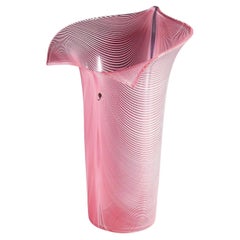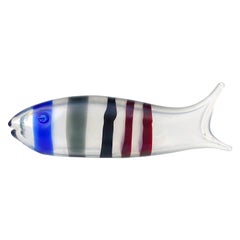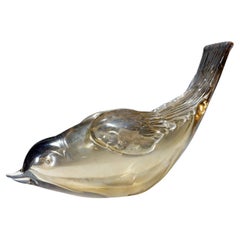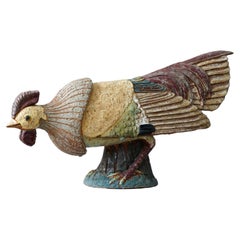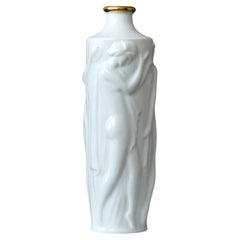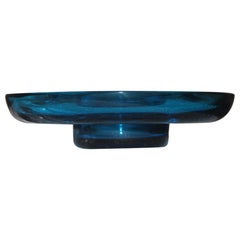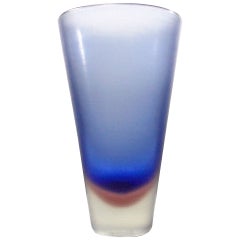Tyra Carolina Lundgren Furniture
to
1
12
1
13
7
4
2
13
11
2
2
2
3
1
8
6
5
5
4
13
8
4
4
1
13
13
13
7
8,866
3,914
2,538
2,229
Creator: Tyra Carolina Lundgren
Tyra Lundgren Vase 'Calla' for Venini
By Venini, Tyra Lundgren Carolina
Located in Berghuelen, DE
Tyra Lundgren Vase 'Calla' for Venini
A calla vase in filigrana glass designed by Tyra Lundgren in 1948, manufactured by Venini, Venice 1981. Incised signa...
Category
Late 20th Century Italian Mid-Century Modern Tyra Carolina Lundgren Furniture
Materials
Art Glass, Murano Glass
Large Tessuto Bowl by Tyra Lundgren for Venini, Murano
By Venini, Tyra Lundgren Carolina
Located in Berghuelen, DE
Large Tessuto Bowl by Tyra Lundgren for Venini, Murano
A large tessuto glass bowl made of transparent glass decorated with fine red canes and an iridized surface. The bowl has a wav...
Category
1980s Italian Mid-Century Modern Vintage Tyra Carolina Lundgren Furniture
Materials
Art Glass
Venini 1930s Tyra Lundgren Murano Iridescent Italian Art Glass Fish Sculpture
By Venini, Tyra Lundgren Carolina
Located in Kissimmee, FL
Very rare and large, antique Murano hand blown "A Fasce" striped Italian art glass fish with iridescent surface sculpture. Documented to Tyra Lundgren circa 1935-1936, fully signed "...
Category
Mid-20th Century Italian Art Deco Tyra Carolina Lundgren Furniture
Materials
Glass, Art Glass, Murano Glass, Sommerso, Blown Glass
$3,750 Sale Price
25% Off
Bird Sculpture by Tyra Lundgren for Venini 1930s
By Tyra Lundgren Carolina, Venini
Located in Berghuelen, DE
Bird Sculpture by Tyra Lundgren for Venini 1930s
A rare bird sculpture made of straw colored glass decorated with an iridized surface. Designed by Tyra Lundgren in 1938, manufacture...
Category
1930s Italian Mid-Century Modern Vintage Tyra Carolina Lundgren Furniture
Materials
Art Glass
Large and Unique Stoneware Rooster by Tyra Lundgren. Sweden, 1955.
By Tyra Lundgren Carolina
Located in Malmö, SE
A stunning and unique stoneware rooster sculpture with amazing glaze.
Made by Tyra Lundgren. Executed in her own studio in Sweden, 1955.
Great condition, but with a couple of chips to the base (pictured).
Signed by the artist in two places, and dated 1955-06-20.
Provenance: bought from the estate of the artist in 1979.
Tyra Lundgren (1897-1979) was one of the most multifaceted artists and modernists of the twentieth century. She was a painter, drawer, sculptor, ceramist, glass- and textile designer, as well as an author and an art critic. She was the first woman who designed glass for Paolo Venini at Murano in Venice and she also served as the artistic leader at Arabia in Helsinki at a time when men tended to hold those kinds of positions.
Tyra Lundgren grew up in Djursholm, near Stockholm. Her parents were John Petter Lundgren, professor at Veterinärinstitutet (institute of veterinary sciences) in Stockholm, and Edith Lundgren née Åberg, who was a housewife and raised their six children. The bourgeois home also comprised a nanny and a female cook. The family were very socially active, travelled often, and enjoyed the outdoor lifestyle. Tyra Lundgren’s schooling began at Djursholm coeducational school, where her teachers included Natanael and Elsa Beskow and Alice Tegnér. Her school friends included Greta Knutson-Tzara, Stellan Mörner, and Ingrid Rydbeck-Zuhr.
Tyra Lundgren knew from the time she was five years old that she wanted to be an artist. She first became aware of the profession through Axel Fahlcrantz, who rented a studio on the plot of land where she lived with her family. In 1913 she began to attend Högre konstindustriella skolan (HKS, now known as Konstfack, college of arts, crafts and design) where she studied decorative art as well as handicrafts in various forms until 1917. One of her fellow students and friends there was Estrid Ericson, who later founded Svenskt Tenn AB in 1924. Whilst attending HKS Tyra Lundgren also took painting lessons at the Althin school of painting. In 1917 she was accepted as a candidate at the Royal Swedish Academy of Fine Arts where, apart from breaks during which she undertook studies abroad, she remained until 1922. She spent a couple of months taking lessons from Anton Hanak in Vienna and from 1920–1923 she was a student of André Lhote in Paris.
Tyra Lundgren was primarily active in four countries: Sweden, Finland, France, and Italy. She spent much of her professional life travelling and considered herself to be a European. Greece and Mexico also formed important centres in her artistic life, as did the USA. She had an extensive social network which included focal individuals within twentieth century-European and American artistic and cultural circles.
Tyra Lundgren’s main artistic motifs were birds, fish, and people which she depicted through different techniques and materials. Her artistic expression involved a variety of different directions and styles. She was a pioneer of the 1920s Swedish Grace style, the name of which had been coined by the art critic Morton Shand at the Stockholm Exhibition of 1930. This was a Swedish Art Deco style, characterised by elegance and traditional art which contrasted with the current artistic ideals of functionalism.
Tyra Lundgren made her debut at a group exhibition held at Kungliga Akademien för de fria konsterna in 1921. She went on to show her work at various exhibitions throughout the 1920s. After that period she only very rarely exhibited her paintings.
Tyra Lundgren’s painted output can be divided into different periods or stylistic directions. The first of these, and the most extensive, was her post-Cubist period which began in 1920 on her arrival in Paris. Her paintings from this time and right up to the mid-1930s typically comprise portraits, self-portraits, live-model painting, still-lifes, interiors, and landscapes in the Cubist style. Many of the great number of self-portraits she painted were produced in the New Objective style, displaying broad variation in terms of clothes, poses and techniques. Two of these – Huvud med vit duk and Självporträtt both from 1921 – can be seen at Moderna Museet in Stockholm, although the majority of these works are at Gotlands Museum.
Tyra Lundgren’s second artistic period comprises the years of 1927 to 1929 and is characterised by the New Objective style inspired by medieval techniques and materials (Giotto, Piero della Francesca). Her motifs were still-lifes and landscapes. At this point she was living in Rome and was close to the circle involved in the Valori plastici: rivista d’arte art journal. This period saw a breakthrough in her development as a painter. From the 1950s through the 1970s her work can almost be described as belonging to the Concrete style. Using light pastel colours her paintings sought light in a sometimes non-figurative expression, but often depicting abstract bird-shapes or other nature-inspired imagery. Her paintings from this period are outsized and display powerful colours, in yellows, reds, and blues.
Tyra Lundgren maintained a constant production of drawings, both in terms of individual artworks and sketches for patterns and designs. She also produced the illustrations for her book Fagert i Fide. Årstiderna på en gammal gotlandsgård, published in 1961. During her early years she also produced advertising illustrations. She spent the final years of her life primarily working with lithographs which were printed at Galleri Prisma and depicted images of doves, swallows, magpies and crows.
Tyra Lundgren is meanwhile best known for her work as a ceramist and in this sphere she was one of Sweden’s leading exponents. She worked in the porcelain industry as a designer and as an artisan and ceramic sculptor. Her first job was at St Eriks Lervarufabrik in Uppsala from 1922–1924, she then worked at Arabia from 1924–1937, and at Rörstrand and Lidköping Porslinsfabrik. She was the artistic leader at Arabia ahead of the 1930 Stockholm Exhibition and she exhibited her work at the World’s Fairs. During the 1934–1938 period she was connected to the Manufacture nationale de Sèvres porcelain factory in Paris.
Tyra Lundgren was a pioneer when it came to giving ceramic art a public space in Sweden. She produced around 20 outsized reliefs in stoneware, so-called monumental reliefs. One of these is Märkeskvinnor, from 1947, for the former girls’ school at Bohusgatan in Stockholm. From the 1940s onwards Tyra Lundgren produced sculptural objects in Chamotte clay and stoneware, with various glazings. Her small birds are well-known and popular with many. When her ceramic efforts became too much for her during the 1970s she then produced models for sculptures in bronze. There are six of these in various places around the globe, including Solfågel in Almedalen, Visby.
Tyra Lundgren began to work as a glassware designer at Moser in Karlsbad in 1922 where she designed new table services and modernised older ones. She also worked freelance for Riihimäki factory in Finland during the 1924–1929 period. From 1934 to 1938 she was employed by Kosta glass factory where she mainly designed thick-walled bowls and vases, engraved with classical motifs. She was introduced to the glassmaker Paolo Venini at Murano during the Triennale di Milano of 1936 and they began a collaboration that lasted into the 1950s. As part of this collaboration Tyra Lundgren became the first woman to design glassware and, in conjunction with the glassblower Arturo Biasutto, she developed new techniques of glass production. Her motifs at this point were birds, fish, snail-shaped designs and leaf-patterned bowls using traditional techniques as well as in new designs. It was during this time that she created the so-called tissue-shaped bowls and it remains unclear as to who specifically came up with the design but Tyra Lundgren claimed it was of her making.
Tyra Lundgren was active as textile designer for Licium (now HV Licium), the sacred textiles...
Category
Mid-20th Century Swedish Scandinavian Modern Tyra Carolina Lundgren Furniture
Materials
Ceramic, Stoneware
White Art Deco Vase by Tyra Lundgren for ALP, Sweden, 1929. Swedish Grace.
By Arabia of Finland, Tyra Lundgren Carolina, Arabia, ALP Lidköping 1
Located in Malmö, SE
A stunning stoneware Art Deco / Swedish Grace vase. Amazing relief decor with hand-painted details in gold.
Designed by Tyra Lundgren in 1928.
This model was produced by both ALP (Lidköpings Porslinsfabrik) in Sweden and Arabia in Finland, which at this time belonged to the same group of companies.
Great condition.
Stamped 'MODELL TYRA LUNDGREN', 'MADE IN SWEDEN' and makers mark.
Tyra Lundgren (1897-1979) was one of the most multifaceted artists and modernists of the twentieth century. She was a painter, drawer, sculptor, ceramist, glass- and textile designer, as well as an author and an art critic. She was the first woman who designed glass for Paolo Venini at Murano in Venice and she also served as the artistic leader at Arabia in Helsinki at a time when men tended to hold those kinds of positions.
Tyra Lundgren grew up in Djursholm, near Stockholm. Her parents were John Petter Lundgren, professor at Veterinärinstitutet (institute of veterinary sciences) in Stockholm, and Edith Lundgren née Åberg, who was a housewife and raised their six children. The bourgeois home also comprised a nanny and a female cook. The family were very socially active, travelled often, and enjoyed the outdoor lifestyle. Tyra Lundgren’s schooling began at Djursholm coeducational school, where her teachers included Natanael and Elsa Beskow...
Category
Mid-20th Century Swedish Art Deco Tyra Carolina Lundgren Furniture
Materials
Ceramic, Stoneware
Small Leaf Bowl by Tyra Lundgren for Venini
By Tyra Lundgren Carolina, Venini
Located in Berghuelen, DE
Small Leaf Bowl by Tyra Lundgren for Venini
Small leaf bowl made of red glass with regular air bubble decoration and a pinched rim. Designed by Tyra Lundgren in the 1930s, manufactu...
Category
1930s Italian Mid-Century Modern Vintage Tyra Carolina Lundgren Furniture
Materials
Art Glass
Tyra Lundgren - VENINI - murano glass leaf - 1950s - 20th century
By Venini, Tyra Lundgren Carolina
Located in Milano, IT
This object is a piece of extreme quality and design made of murano glass by designer TYRA LUNDGREN for VENINI, a collector's item for a connoisseur.
Category
1950s Italian Mid-Century Modern Vintage Tyra Carolina Lundgren Furniture
Materials
Murano Glass
Stoneware Leaf by Tyra Lundgren. Manufacture nationale de Sèvres, 1930s.
By Manufacture Nationale de Sèvres, Tyra Lundgren Carolina
Located in Malmö, SE
A beautiful stoneware bowl with amazing glaze.
Made by Tyra Lundgren. Executed during the artist's time spent at Sèvres, between 1934-1939.
Excellent condition.
Impressed with artist's name and maker's marks.
Tyra Lundgren (1897-1979) was one of the most multifaceted artists and modernists of the twentieth century. She was a painter, drawer, sculptor, ceramist, glass- and textile designer, as well as an author and an art critic. She was the first woman who designed glass for Paolo Venini at Murano in Venice and she also served as the artistic leader at Arabia in Helsinki at a time when men tended to hold those kinds of positions.
Tyra Lundgren grew up in Djursholm, near Stockholm. Her parents were John Petter Lundgren, professor at Veterinärinstitutet (institute of veterinary sciences) in Stockholm, and Edith Lundgren née Åberg, who was a housewife and raised their six children. The bourgeois home also comprised a nanny and a female cook. The family were very socially active, travelled often, and enjoyed the outdoor lifestyle. Tyra Lundgren’s schooling began at Djursholm coeducational school, where her teachers included Natanael and Elsa Beskow and Alice Tegnér. Her school friends included Greta Knutson-Tzara, Stellan Mörner, and Ingrid Rydbeck-Zuhr.
Tyra Lundgren knew from the time she was five years old that she wanted to be an artist. She first became aware of the profession through Axel Fahlcrantz, who rented a studio on the plot of land where she lived with her family. In 1913 she began to attend Högre konstindustriella skolan (HKS, now known as Konstfack, college of arts, crafts and design) where she studied decorative art as well as handicrafts in various forms until 1917. One of her fellow students and friends there was Estrid Ericson, who later founded Svenskt Tenn AB in 1924. Whilst attending HKS Tyra Lundgren also took painting lessons at the Althin school of painting. In 1917 she was accepted as a candidate at the Royal Swedish Academy of Fine Arts where, apart from breaks during which she undertook studies abroad, she remained until 1922. She spent a couple of months taking lessons from Anton Hanak in Vienna and from 1920–1923 she was a student of André Lhote in Paris.
Tyra Lundgren was primarily active in four countries: Sweden, Finland, France, and Italy. She spent much of her professional life travelling and considered herself to be a European. Greece and Mexico also formed important centres in her artistic life, as did the USA. She had an extensive social network which included focal individuals within twentieth century-European and American artistic and cultural circles.
Tyra Lundgren’s main artistic motifs were birds, fish, and people which she depicted through different techniques and materials. Her artistic expression involved a variety of different directions and styles. She was a pioneer of the 1920s Swedish Grace style, the name of which had been coined by the art critic Morton Shand at the Stockholm Exhibition of 1930. This was a Swedish Art Deco style, characterised by elegance and traditional art which contrasted with the current artistic ideals of functionalism.
Tyra Lundgren made her debut at a group exhibition held at Kungliga Akademien för de fria konsterna in 1921. She went on to show her work at various exhibitions throughout the 1920s. After that period she only very rarely exhibited her paintings.
Tyra Lundgren’s painted output can be divided into different periods or stylistic directions. The first of these, and the most extensive, was her post-Cubist period which began in 1920 on her arrival in Paris. Her paintings from this time and right up to the mid-1930s typically comprise portraits, self-portraits, live-model painting, still-lifes, interiors, and landscapes in the Cubist style. Many of the great number of self-portraits she painted were produced in the New Objective style, displaying broad variation in terms of clothes, poses and techniques. Two of these – Huvud med vit duk and Självporträtt both from 1921 – can be seen at Moderna Museet in Stockholm, although the majority of these works are at Gotlands Museum.
Tyra Lundgren’s second artistic period comprises the years of 1927 to 1929 and is characterised by the New Objective style inspired by medieval techniques and materials (Giotto, Piero della Francesca). Her motifs were still-lifes and landscapes. At this point she was living in Rome and was close to the circle involved in the Valori plastici: rivista d’arte art journal. This period saw a breakthrough in her development as a painter. From the 1950s through the 1970s her work can almost be described as belonging to the Concrete style. Using light pastel colours her paintings sought light in a sometimes non-figurative expression, but often depicting abstract bird-shapes or other nature-inspired imagery. Her paintings from this period are outsized and display powerful colours, in yellows, reds, and blues.
Tyra Lundgren maintained a constant production of drawings, both in terms of individual artworks and sketches for patterns and designs. She also produced the illustrations for her book Fagert i Fide. Årstiderna på en gammal gotlandsgård, published in 1961. During her early years she also produced advertising illustrations. She spent the final years of her life primarily working with lithographs which were printed at Galleri Prisma and depicted images of doves, swallows, magpies and crows.
Tyra Lundgren is meanwhile best known for her work as a ceramist and in this sphere she was one of Sweden’s leading exponents. She worked in the porcelain industry as a designer and as an artisan and ceramic sculptor. Her first job was at St Eriks Lervarufabrik in Uppsala from 1922–1924, she then worked at Arabia from 1924–1937, and at Rörstrand and Lidköping Porslinsfabrik. She was the artistic leader at Arabia ahead of the 1930 Stockholm Exhibition and she exhibited her work at the World’s Fairs. During the 1934–1938 period she was connected to the Manufacture nationale de Sèvres porcelain factory in Paris.
Tyra Lundgren was a pioneer when it came to giving ceramic art a public space in Sweden. She produced around 20 outsized reliefs in stoneware, so-called monumental reliefs. One of these is Märkeskvinnor, from 1947, for the former girls’ school at Bohusgatan in Stockholm. From the 1940s onwards Tyra Lundgren produced sculptural objects in Chamotte clay and stoneware, with various glazings. Her small birds are well-known and popular with many. When her ceramic efforts became too much for her during the 1970s she then produced models for sculptures in bronze. There are six of these in various places around the globe, including Solfågel in Almedalen, Visby.
Tyra Lundgren began to work as a glassware designer at Moser in Karlsbad in 1922 where she designed new table services and modernised older ones. She also worked freelance for Riihimäki factory in Finland during the 1924–1929 period. From 1934 to 1938 she was employed by Kosta glass factory where she mainly designed thick-walled bowls and vases, engraved with classical motifs. She was introduced to the glassmaker Paolo Venini at Murano during the Triennale di Milano of 1936 and they began a collaboration that lasted into the 1950s. As part of this collaboration Tyra Lundgren became the first woman to design glassware and, in conjunction with the glassblower Arturo Biasutto, she developed new techniques of glass production. Her motifs at this point were birds, fish, snail-shaped designs and leaf-patterned bowls using traditional techniques as well as in new designs. It was during this time that she created the so-called tissue-shaped bowls and it remains unclear as to who specifically came up with the design but Tyra Lundgren claimed it was of her making.
Tyra Lundgren was active as textile designer for Licium (now HV Licium), the sacred textiles...
Category
Mid-20th Century French Scandinavian Modern Tyra Carolina Lundgren Furniture
Materials
Ceramic, Stoneware
1950 Tyra Lundgren Venini Murano Glass White Filigrana Leaf Bowl
By Tyra Lundgren Carolina, Venini
Located in Brescia, IT
"Leaf" Bowl
Tyra Lundgren
Venini, 1950
White Glass "Mezza Filigrana"
Showed at Biennale of Venice 1938
Excellent Condiction
No cracks
Category
1940s Italian Mid-Century Modern Vintage Tyra Carolina Lundgren Furniture
Materials
Murano Glass
Midcentury Stoneware Wall Piece by Tyra Lundgren, Gustavsberg, 1940s
By Gustavsberg, Tyra Lundgren Carolina
Located in Stockholm, SE
Striking stoneware wall relief by Tyra Lundgren, with a colorful, abstract motif of three dancing women. Beautiful colors and and thick glazes on tactile chamotte.
Mounted on a wood...
Category
1940s Swedish Scandinavian Modern Vintage Tyra Carolina Lundgren Furniture
Materials
Stoneware
Small Leaf Bowl by Tyra Lundgren for Venini 1950s
By Venini, Tyra Lundgren Carolina
Located in Berghuelen, DE
Small Leaf Bowl by Tyra Lundgren for Venini 1950s
Small bowl made of green glass with regular air bubble decoration and a pinched rim. Designed by Tyra Lundgren in the 1930s, manufa...
Category
1950s Italian Mid-Century Modern Vintage Tyra Carolina Lundgren Furniture
Materials
Art Glass
Tyra Lundgren, sculpture in stoneware, Sweden 1960s
By Tyra Lundgren Carolina
Located in Stockholm, SE
A unique, partially glazed stoneware sculpture by Tyra Lundgren (Swe 1897-1979). One of the most versetile artist of the 20th Century, she is most known for her ceramics for Gustavsb...
Category
1950s Swedish Scandinavian Modern Vintage Tyra Carolina Lundgren Furniture
Materials
Stoneware
Related Items
Minimal Venini Round Blu Bowl Glass Murano 1984 Signed Italian Design
By Venini
Located in Palermo, Sicily
Minimal Venini round blu bowl glass Murano 1984 signed Italian Design.
Category
1980s Italian Mid-Century Modern Vintage Tyra Carolina Lundgren Furniture
Materials
Murano Glass
Paolo Venini Inciso Vase
By Venini
Located in West Palm Beach, FL
This is a clean example with pleasing proportions
Category
1950s Italian Vintage Tyra Carolina Lundgren Furniture
Materials
Art Glass
Art Deco Pewter Handle Vase by GAB Guldsmedsaktiebolaget, Swedish Grace, 1930s
By GAB Guldsmedsaktiebolaget
Located in Stockholm, SE
An Art Deco pewter vase, crafted in 1935 by the esteemed Swedish company GAB (Guldsmedsaktiebolaget), exemplifies the sleek, minimalist design that defines Scandinavian craftsmanship...
Category
1930s Art Deco Vintage Tyra Carolina Lundgren Furniture
Materials
Pewter
$1,141
H 7.2 in Dm 4.1 in
White Fulvio Bianconi Handkerchief Bowl, Zanfirico Filigree Glass, Venini Murano
By Venini
Located in Stockholm, SE
Handkerchief ''zanfirico'' bowl/vase designed by Fulvio Bianconi for Venini, Murano. This fazzoletto bowl features zanfirico glass with lattimo white netted vertical cane and white ...
Category
1950s Italian Mid-Century Modern Vintage Tyra Carolina Lundgren Furniture
Materials
Art Glass, Blown Glass
$901
H 2.56 in Dm 3.15 in
Venini Two-Tone Tall Vase 'Signed'
By Venini
Located in North Miami, FL
Reverse cone shape with vivid turquoise blue glass ring on black glass base. SIGNED and dated to bottom.
Category
Late 20th Century Italian Tyra Carolina Lundgren Furniture
Materials
Murano Glass
Art Deco "Argenta" Vase by Wilhelm Kåge for Gustavsberg, Sweden
By Wilhelm Kage, Gustavsberg
Located in Stockholm, SE
Scandinavian Modern Wilhelm Kåge "Argenta" Vase in stoneware and inlays in silver for Gustavsberg, Sweden. This beautiful piece is part of the Wilhelm Kages (Kåge) Argenta series, pr...
Category
1930s Swedish Scandinavian Modern Vintage Tyra Carolina Lundgren Furniture
Materials
Silver
Fulvio Bianconi Blue Handkerchief Bowl from Venini, Murano Italy
By Venini
Located in Stockholm, SE
Handkerchief bowl/vase designed by Fulvio Bianconi for Venini, Murano. This fazzoletto bowl features zanfirico glass with lattimo white netted vertical cane and light blue ribbons, s...
Category
1950s Italian Mid-Century Modern Vintage Tyra Carolina Lundgren Furniture
Materials
Art Glass, Blown Glass
Venini vase Colletti series 70’s
By Venini, Alessandro Diaz de Santillana
Located in bari, IT
Colletti series vase in greenish blown glass with two-tone incalmo band decoration designer Alessandro Diaz de Santillana. Venini engraved signature.
After graduating in architecture...
Category
1970s Italian Mid-Century Modern Vintage Tyra Carolina Lundgren Furniture
Materials
Murano Glass
Art Deco Bronze Vase by Bowi, Sweden, 1930s
Located in Göteborg, SE
Modernist bronze vase from the 1930s with a sculptural, geometric design. The form combines a spherical base with sharp vertical and curved elements, giving it a bold architectural p...
Category
1930s Swedish Art Deco Vintage Tyra Carolina Lundgren Furniture
Materials
Bronze
Art Deco Art Deco Bronze Vase by GAB, Guldsmedsaktiebolaget, Sweden, 1930s
By GAB Guldsmedsaktiebolaget
Located in Stockholm, SE
Art Deco bronze vase attributed to celebrated Swedish silversmith Jacob Ängman for GAB (Guldsmedsaktiebolaget). Crafted in the 1930s and made from solid bronze, it features a rich pa...
Category
1930s Swedish Art Deco Vintage Tyra Carolina Lundgren Furniture
Materials
Bronze
$1,321
H 7.09 in Dm 3.35 in
Sergio Asti for Venini Large Murano Glass Ashtray , Italy, 1967
By Sergio Asti, Venini
Located in Milan, IT
Sergio Asti for Venini Glass Large Ashtray.
From the renowned DE'MODE'S series
Designed on the occasion of the remodeling of the Bar Excelsior at the Excelsior Hotel Lido of Venice....
Category
1960s Italian Mid-Century Modern Vintage Tyra Carolina Lundgren Furniture
Materials
Murano Glass
Mid-Century Modern Murano Glass Art Glass Fish Sculpture by Licio Zanetti
By Licio Zanetti
Located in Philadelphia, PA
An abstract Murano glass sculpture of a fish by Licio Zanetti for Zanetti Vetreria Artistica. The clear glass fish is twisted as if jumping through the air and mounted on a stylized ...
Category
Mid-20th Century Italian Mid-Century Modern Tyra Carolina Lundgren Furniture
Materials
Art Glass
$1,450
H 12 in W 9 in D 9 in
Previously Available Items
mid-century modern pink filigrana murano glass vase venini, Italy, 1989
By Venini, Tyra Lundgren Carolina
Located in Nicolosi, IT
mid-century modern pink filigrana murano glass vase venini, Italy, 1989
Illuminate your space with the enchanting beauty of this Murano glass ...
Category
1980s Italian Mid-Century Modern Vintage Tyra Carolina Lundgren Furniture
Materials
Murano Glass
Venini Tyra Lundgren Murano Fully Signed Pink Italian Art Glass Bird Figurine
By Tyra Lundgren Carolina, Venini
Located in Kissimmee, FL
Beautiful, and rare antique Murano hand blown Sommerso pink Italian art glass bird figurine / sculpture. Documented to designer Tyra Lundgren for ...
Category
Mid-20th Century Italian Art Deco Tyra Carolina Lundgren Furniture
Materials
Glass, Art Glass, Blown Glass, Murano Glass, Sommerso
H 4.13 in W 3 in D 4.75 in
VENINI # Tyra Lundgren# Vase Filigrana Glass 1989 Murano Italy
By Tyra Lundgren Carolina
Located in Milano, IT
Vase VENINI.
Category
1980s Italian Other Vintage Tyra Carolina Lundgren Furniture
Materials
Murano Glass
Tyra Lundgren Designed Ceramic Globe Lamp for Alp Lidkoping, Sweden, 1930's
By Tyra Lundgren Carolina
Located in New York, NY
Tyra Lundgren designed this ceramic globe lamp on rectangular legs. The surface has horizontal ribs, some detailed in gold. Newly rewired for use in the USA with all brass polished hardware. Made by ALP...
Category
Mid-20th Century Scandinavian Scandinavian Modern Tyra Carolina Lundgren Furniture
Materials
Gold, Brass
H 21.5 in W 10 in D 10 in
Swivel Chair Designed by Gillis Lundgren for Ikea in the 1960s, Model Mila
By IKEA, Tyra Lundgren Carolina
Located in Den Haag, NL
Swivel chair designed by Gillis Lundgren for Ikea in the 1960s. Model Mila.
The chair is upholstered in black faux leather and stands on a chrome star base.
Sit comfortably.
...
Category
1960s Swedish Mid-Century Modern Vintage Tyra Carolina Lundgren Furniture
Materials
Faux Leather
H 28.75 in W 24.81 in D 28.35 in
Stoneware Bird by Tyra Lindgren for Gustavsberg, Sweden, 1940s
By Tyra Lundgren Carolina, Gustavsberg
Located in Stockholm, SE
Lovely stoneware figurine by Tyra Lundgren in the form of a small bird. Intense and sensitive expression. Unglazed areas contrast with the thick, nature colored glazes that have flow...
Category
1940s Swedish Scandinavian Modern Vintage Tyra Carolina Lundgren Furniture
Materials
Stoneware
Pair of Birds Sculpture Hand Blown Glass by Tyra Lundgren for Paolo Venini 1940
By Tyra Lundgren Carolina, Paolo Venini
Located in London, GB
Two chirping birds were hand blown from transparent pagliesco (straw – coloured) glass with particles of gold flecks floating in the body of the birds for Venini, model no. 2627, blo...
Category
1930s Italian Mid-Century Modern Vintage Tyra Carolina Lundgren Furniture
Materials
Murano Glass, Art Glass, Blown Glass
H 5.12 in W 6.3 in D 3.75 in
Venini Tyra Lundgren Murano Iridescent Blue Italian Art Glass Bird Sculpture
By Venini, Tyra Lundgren Carolina
Located in Kissimmee, FL
Beautiful, and rare Murano hand blown cobalt blue and clear wings, heavy iridescent Italian art glass bird sculpture. Documented to designer Tyra Lundgren for Venini, circa 1935-1936...
Category
Mid-20th Century Italian Art Deco Tyra Carolina Lundgren Furniture
Materials
Art Glass, Blown Glass, Murano Glass, Sommerso, Glass
H 7.13 in W 4 in D 8.38 in
Pair of Chirping Birds, Hand Blown Iridescent Gold Crystal Glass by Paolo Venini
By Tyra Lundgren Carolina, Paolo Venini
Located in London, GB
Two birds in thick transparent pagliesco (straw – coloured) glass. Paolo Venini invited Swedish designer Tyra Lundgren to try her talents with Murano glass after the 20st Venice bien...
Category
1930s Italian Mid-Century Modern Vintage Tyra Carolina Lundgren Furniture
Materials
Art Glass, Blown Glass, Murano Glass
H 5.12 in W 6.3 in D 3.55 in
Sculpture Designed by Tyra Lundgren for Gustavsberg, Sweden, 1950s
By Tyra Lundgren Carolina
Located in Stockholm, SE
Chamotte stoneware, partly glazed in different beige shades.
Stamped: Tyra Lundgren, Gustavsberg.
Category
1950s Swedish Mid-Century Modern Vintage Tyra Carolina Lundgren Furniture
Materials
Stoneware
Stoneware Wall Relief by Tyra Lundgren
By Tyra Lundgren Carolina, Gustavsberg
Located in Stockholm, SE
Striking stoneware wall relief by Tyra Lundgren, in a colorful, buoyant design of sunflowers and birds. Birds, delicate and expressive, were a recurring theme in Tyra Lundgren’s work...
Category
1950s Swedish Scandinavian Modern Vintage Tyra Carolina Lundgren Furniture
Materials
Stoneware
Tyra Carolina Lundgren furniture for sale on 1stDibs.
Tyra Carolina Lundgren furniture are available for sale on 1stDibs. These distinctive items are frequently made of murano glass and are designed with extraordinary care. There are many options to choose from in our collection of Tyra Carolina Lundgren furniture, although pink editions of this piece are particularly popular. Many of the original furniture by Tyra Carolina Lundgren were created in the mid-century modern style in europe during the 20th century. If you’re looking for additional options, many customers also consider furniture by Gabriella Binazzi, MVM Cappelin, and ICET Murano. Prices for Tyra Carolina Lundgren furniture can differ depending upon size, time period and other attributes — on 1stDibs, these items begin at $950 and can go as high as $5,000, while a piece like these, on average, fetch $1,774.
